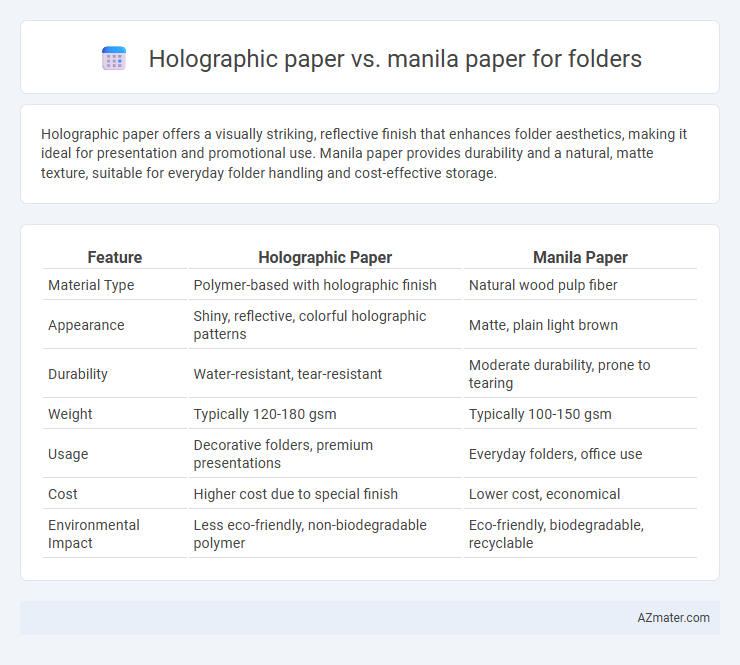Holographic paper offers a visually striking, reflective finish that enhances folder aesthetics, making it ideal for presentation and promotional use. Manila paper provides durability and a natural, matte texture, suitable for everyday folder handling and cost-effective storage.
Table of Comparison
| Feature | Holographic Paper | Manila Paper |
|---|---|---|
| Material Type | Polymer-based with holographic finish | Natural wood pulp fiber |
| Appearance | Shiny, reflective, colorful holographic patterns | Matte, plain light brown |
| Durability | Water-resistant, tear-resistant | Moderate durability, prone to tearing |
| Weight | Typically 120-180 gsm | Typically 100-150 gsm |
| Usage | Decorative folders, premium presentations | Everyday folders, office use |
| Cost | Higher cost due to special finish | Lower cost, economical |
| Environmental Impact | Less eco-friendly, non-biodegradable polymer | Eco-friendly, biodegradable, recyclable |
Introduction to Holographic Paper and Manila Paper
Holographic paper features a reflective, rainbow-like surface created through micro-embossing technology, making it ideal for eye-catching folders used in marketing or special presentations. Manila paper is a durable, lightweight kraft paper known for its natural tan color and versatility, commonly used in folders for office, school, and archival purposes. The choice between holographic and manila paper depends on the need for visual appeal versus durability and cost-effectiveness in folder production.
Material Composition and Manufacturing Process
Holographic paper is composed of a base paper sheet laminated with a thin layer of polyester film embedded with microstructures that create a reflective, light-refracting surface, enhancing visual appeal through intricate holographic patterns. Manila paper, traditionally made from abaca fibers or wood pulp, undergoes a pulping and pressing process that results in a sturdy, fibrous sheet known for its durability and natural brown color. The manufacturing of holographic paper involves advanced coating and embossing techniques to apply and pattern the holographic film, while manila paper production relies on conventional pulp processing and drying methods, emphasizing strength and cost-efficiency for folders.
Visual Appeal and Design Options
Holographic paper offers vibrant, eye-catching visual appeal with its reflective, multi-dimensional surface, making folders stand out with dynamic color shifts under light. Manila paper provides a classic, neutral tone ideal for minimalist and professional designs, allowing for versatile customization with stamps, prints, or labels. Designers prioritize holographic paper for flashy, modern aesthetics, while manila paper suits traditional or eco-friendly folder styles.
Durability and Strength Comparison
Holographic paper offers enhanced visual appeal but generally lacks the durability and tear resistance of Manila paper, which is known for its robust fiber composition. Manila paper's strong structure provides superior strength, making it ideal for folders requiring long-lasting protection and frequent handling. While holographic paper may resist moisture better due to its coating, Manila paper remains the preferred choice for durability in heavy-use folder applications.
Cost and Affordability Analysis
Holographic paper typically costs 30-50% more than manila paper due to its specialized printing technology and reflective surface, driving up production expenses for folders. Manila paper remains the most affordable option, with a price range of $0.05 to $0.15 per sheet, making it ideal for bulk folder manufacturing where budget constraints are critical. Choosing manila paper ensures cost-effectiveness without compromising functionality, whereas holographic paper should be reserved for premium folders requiring visual appeal despite higher costs.
Environmental Impact and Sustainability
Holographic paper often contains plastic films and metallic coatings, making it less biodegradable and more challenging to recycle compared to manila paper, which is typically made from natural fibers and is fully recyclable and biodegradable. The production of manila paper generally consumes fewer resources and generates lower carbon emissions, promoting a smaller environmental footprint. Choosing manila paper for folders supports sustainable practices by reducing landfill waste and conserving natural resources.
Suitability for Office Use
Holographic paper offers a visually striking appearance ideal for creating attention-grabbing folders, but its glossy texture may be prone to fingerprints and less durable under heavy handling common in office environments. Manila paper, known for its sturdiness and smooth, matte finish, provides practical durability and ease of writing or labeling, making it a preferred choice for daily office folder use. While holographic paper excels in professional presentations or promotional materials, manila paper ensures longer-lasting functionality and cost-efficiency for routine document organization.
Customization and Printing Compatibility
Holographic paper offers vibrant, eye-catching designs with smooth surfaces ideal for high-resolution digital printing and intricate customization such as foil stamping or embossing, enhancing the visual appeal of folders. Manila paper provides a sturdy, cost-effective option with a matte finish that supports basic printing techniques like laser or inkjet, suitable for straightforward branding or labels but less effective for detailed graphics or embellishments. Choosing between holographic and manila paper for folders depends on the desired customization level and printing technology compatibility, where holographic paper excels in premium, decorative printing and manila paper meets practical, budget-friendly needs.
User Experience and Practicality
Holographic paper offers a visually striking and unique design ideal for presentations or special projects, enhancing user engagement through its reflective, colorful surface. Manila paper provides superior durability and a smooth texture, making it practical for everyday folder use where strength and ease of writing or labeling are priorities. For user experience, holographic paper excels in aesthetic appeal, while Manila paper is preferred for functionality and longevity in handling.
Final Verdict: Which is Better for Folders?
Holographic paper offers a visually striking, reflective surface that enhances folder aesthetics and draws attention, making it ideal for presentation or promotional materials. Manila paper provides durability, cost-effectiveness, and ease of writing or printing, making it better suited for everyday use and professional documentation. For folders requiring a balance between appearance and practicality, holographic paper suits decorative purposes, while manila paper remains the superior choice for functional, long-lasting folders.

Infographic: Holographic paper vs Manila paper for Folder
 azmater.com
azmater.com